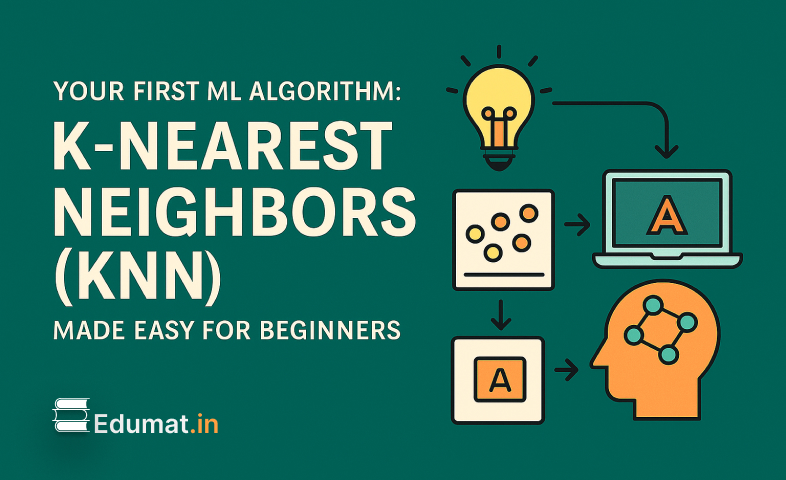Your First ML Algorithm: K-Nearest Neighbors (KNN) Made Easy for Beginners
Machine Learning • June 11, 2025

Mukesh Juadi

So you’ve taken your first step into the world of machine learning — awesome! In our previous blog, we explored what machine learning is and how it’s slowly becoming a part of our everyday life. Now, it’s time to get our hands dirty (well, virtually) with one of the simplest and most beginner-friendly algorithms out there: K-Nearest Neighbors (KNN).
Let’s break it down in the most human way possible.
What is KNN, and Why Should You Care?
KNN is like that one helpful friend who gives you suggestions based on what others have done. For example, imagine you’re trying to decide which movie to watch, and you ask a few friends who have similar taste — you usually end up trusting their suggestions, right?
That’s basically how KNN works. It looks at the data points closest to the one you’re trying to classify and makes a decision based on the "majority vote" from those neighbors.
Real-Life Example: KNN in Action
Let’s say you’ve got a basket of fruits. Some are apples, some are oranges, and you know what each one is based on their size and color. Now, a new fruit comes in — you don’t know what it is yet.
What do you do?
You look around at the fruits closest in size and color. If most of them are apples, you guess the new fruit is also an apple.
Simple, right? That’s KNN in action.
How Does KNN Actually Work?
Here’s a step-by-step of how the KNN algorithm works behind the scenes:
- Store the data
KNN doesn’t do any learning when you feed it data. It just stores everything and waits. - Pick a number — k
This is the number of neighbors you’ll check. Common choices are 3, 5, or 7. If you choose k = 3, you’re asking: “What do the 3 nearest neighbors think?” - Measure the distance
The algorithm calculates the distance between the new data point and every other point (usually using something called Euclidean distance — like a straight line on a graph). - Look at the k nearest neighbors
Once the distances are sorted, it grabs the k closest ones. - Vote and classify
It checks the labels of those k neighbors (apple? orange?) and assigns the most common label to the new point.
Is KNN Actually Learning?
Not really. KNN is considered a “lazy learner” because it doesn’t learn patterns in advance. Instead, it waits until you ask it to make a prediction and then looks at the data to figure things out. That makes it simple, but also a bit slow with large datasets.
When Should You Use KNN?
KNN is a great choice when:
- You’re just starting out in machine learning
- Your dataset is small and easy to visualize
- You want to build a model quickly without too much math
- You’re working with classification problems (e.g., spam vs. not spam, fruit types, etc.)
But if your data is huge or very complex, KNN might not be the best option — it can become slow and confused with noisy data.
Tools You Can Use
You don’t need to build KNN from scratch (unless you want to for fun!). Here are some beginner-friendly tools and libraries:
- Python + scikit-learn – Simple and well-documented
- Google Colab – You can try code online for free
- Jupyter Notebook – Great for practicing and visualizing steps
Here's a super simple KNN code snippet in Python using scikit-learn:
from sklearn.neighbors import KNeighborsClassifier
# Sample data
X = [[1, 2], [2, 3], [3, 1], [6, 5], [7, 7]]
y = ['apple', 'apple', 'apple', 'orange', 'orange']
# Create the model
knn = KNeighborsClassifier(n_neighbors=3)
knn.fit(X, y)
# Predict a new point
print(knn.predict([[4, 3]])) # Output: ['apple']
🧭 Final Thoughts
K-Nearest Neighbors is a great starting point for anyone dipping their toes into machine learning. It’s simple, visual, and easy to understand. Once you get the hang of how it works, you’ll start to see how similar logic applies to more advanced algorithms too.
In the next blog, we’ll dive into another cool concept — probably something like Decision Trees or Linear Regression (stay tuned!).
Until then, try creating your own mini-classifier using KNN. Maybe classify songs, books, or even food recipes — have fun learning! 🎓🚀
🔖 Tags
K-Nearest Neighbors KNN algorithm machine learning for beginners Python machine learning scikit-learn KNN classification algorithm